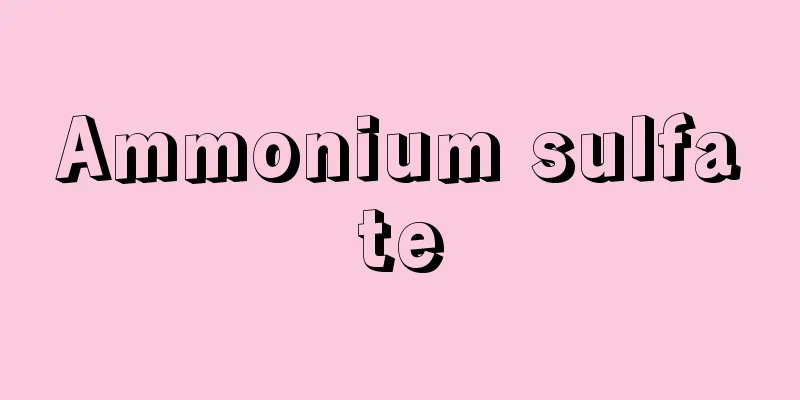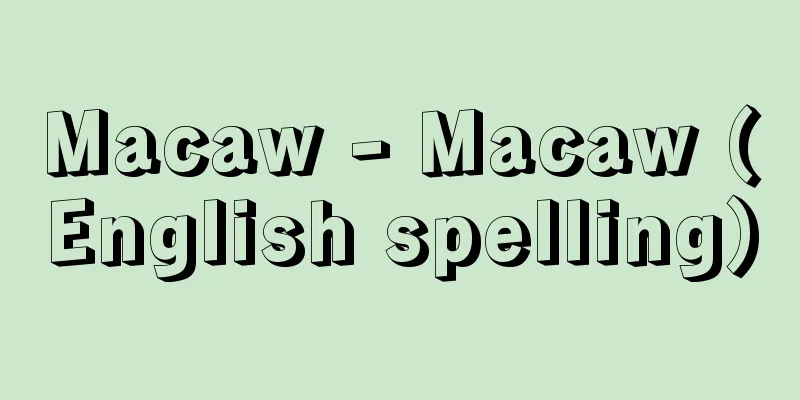Ammonium sulfate

|
Ammonium sulfate is the industrial common name for ammonium sulfate, the most common chemical fertilizer, also used in cellophane, leather tanning, and as a food additive. It is a fast-acting nitrogen fertilizer, and the fertilizer effect of nitrogen fertilizers is often evaluated based on ammonium sulfate. The first use of ammonium sulfate in Japan dates back to 1896 (Meiji 29). It was domestically produced five years later, when Tokyo Gas Co. began producing it as a by-product. Ammonium sulfate has the chemical composition ( NH4 ) 2SO4 and is a colorless, transparent crystal that dissolves well in water, but recovered by-product ammonium sulfate (described below) may be colored due to impurities. Pure ammonium sulfate contains 21.2% nitrogen, but for fertilizer, the regulation requires ammonia nitrogen content of 20.5% or more. It is an excellent fertilizer that is easily absorbed by soil, suitable for basal and top dressing, does not absorb moisture, and is easy to handle. It is particularly suitable for crops that like sulfur, such as rice, beans, mandarin oranges, tea, and cotton. However, although it is chemically neutral, it has the disadvantage of promoting the runoff of lime and magnesia in the soil and making the soil acidic due to the influence of the secondary component sulfuric acid, so it is necessary to replenish lime, but care must be taken because if ammonium sulfate and lime are mixed directly, it will be lost into the atmosphere as ammonia, causing a considerable loss. In addition, iron should not be applied to aging rice paddies that are deficient in iron, as sulfuric acid is reduced in the soil to hydrogen sulfide, which damages rice roots and reduces yields. There are three types of ammonium sulfate: synthetic ammonium sulfate, which is made by neutralizing the raw materials ammonia and sulfuric acid; by-product ammonium sulfate obtained as a by-product from nitrogen compounds in coal and petroleum, such as in the production of coke and direct desulfurization of heavy oil; and recovered ammonium sulfate, which is made by recovering the remaining ammonia or sulfuric acid after using the ammonia for other purposes, such as in the production of caprolactam, a raw material for nylon, as ammonium sulfate. Of the ammonium sulfate currently manufactured in Japan, recovered ammonium sulfate accounts for the majority, accounting for approximately 80% of the total production. In 1958 (Showa 33), annual production of ammonium sulfate reached 2.6 million tons, but due to the expansion of production of other chemical fertilizers such as urea and ammonium chloride and the decline in consumption, this figure had fallen to 1.32 million tons in 2010 (Heisei 22). [Yuki Koyama] "Fertilizer Handbook, 5th Edition, edited by Date Noboru and Shiozaki Hisao (1997, Rural Culture Association)" ▽ "Fertilizer Yearbook, various editions, edited by the Fertilizer Association Newspaper Division (Fertilizer Association)" [Reference] | | | fertilizers| | |Source: Shogakukan Encyclopedia Nipponica About Encyclopedia Nipponica Information | Legend |
|
硫酸アンモニウムの工業上の慣用名で、セロファン、皮なめし、食品添加物などにも使われる、もっとも代表的な化学肥料である。速効性の窒素肥料で、窒素肥料の肥効は硫安を基準として評価されることが多い。日本で硫安が初めて使用されたのは1896年(明治29)にさかのぼる。国産化はその5年後で、東京瓦斯(ガス)が副産物として生産を開始したのが最初である。 硫安は(NH4)2SO4の化学組成をもち、水によく溶ける無色透明の結晶であるが、回収副生硫安(後述)の場合には不純物のため着色していることがある。純品は窒素21.2%を含有するが、肥料用はアンモニア性窒素20.5%以上と規定されている。土壌に吸着されやすく、基肥にも追肥にも適しており、吸湿性もなく取扱いの容易な優れた肥料である。水稲、豆類、ミカン、チャ(茶)、ワタ(綿)など硫黄(いおう)を好む作物ではとくに好適な肥料である。しかし、化学的には中性であるが、副成分の硫酸の影響で土壌中の石灰、苦土の流亡を助長して土壌を酸性にする欠点があるので石灰を補給する必要があるが、硫安と石灰を直接混合するとアンモニアとして大気中に失われ、かなりの損失をおこすので、注意しなければならない。また、鉄の欠乏した老朽化水田では硫酸が土壌中で還元されて硫化水素となり、イネの根を傷め減収を招くので、施してはならない。 硫安の種類には、原料のアンモニアと硫酸の中和反応によってつくられる合成硫安、コークスの製造や重油の直接脱硫など石炭や石油中の窒素化合物から副産物として得られる副生硫安、ナイロン原料のカプロラクタム製造など、いったんほかの用途に用いたのちさらに残存するアンモニアまたは硫酸を硫安として回収した回収硫安がある。 現在日本で製造される硫安は、回収硫安が生産量の約80%を占めもっとも多い。1958年(昭和33)には年産260万トンに達した硫安も、尿素や塩安など他の化学肥料の生産拡大と消費の低落で、2010年(平成22)には132万トンと落ち込んでいる。 [小山雄生] 『伊達昇・塩崎尚郎編著『肥料便覧』第5版(1997・農山漁村文化協会)』▽『肥料協会新聞部編『肥料年鑑』各年版(肥料協会)』 [参照項目] | | | | | |出典 小学館 日本大百科全書(ニッポニカ)日本大百科全書(ニッポニカ)について 情報 | 凡例 |
Recommend
Comb
〘noun〙 The ridge of a roof. Source: The Selected E...
Late adolescence
…Men and women respond slightly differently to se...
One-dimensional society
...This term itself began to be used in the Japan...
Siping - Shihei
A prefecture-level city in the southwestern corne...
Vespa crabro (English spelling)
…[Shiro Katsuya]. . . *Some of the terminology th...
classical control theory
…Until 1960, a method was developed and systemati...
strategy of nuclear deterrence
...For this deterrence to be effective, three con...
Pó tǎ (English spelling)
A tower in Guoxiang Temple, southeast of Kaifeng C...
Awata clan
An ancient powerful clan. A relative of the Wani c...
Leptodora richardi
Class: Branchiopods, Order: Bivalvia, Family: Lept...
Remission period
…That is, close cooperation between the patient, ...
Ichthyophiidae
…Most are about 24-30 cm in length. (1) The Ichth...
Blue mussel (purple-lipped mussel)
A bivalve mollusk of the Mytilidae family (illustr...
Mount Paektu
A volcano straddling the border between North Kor...
Air spinning frame; open end spinning frame
Used in the process of twisting to make yarn. A sp...









